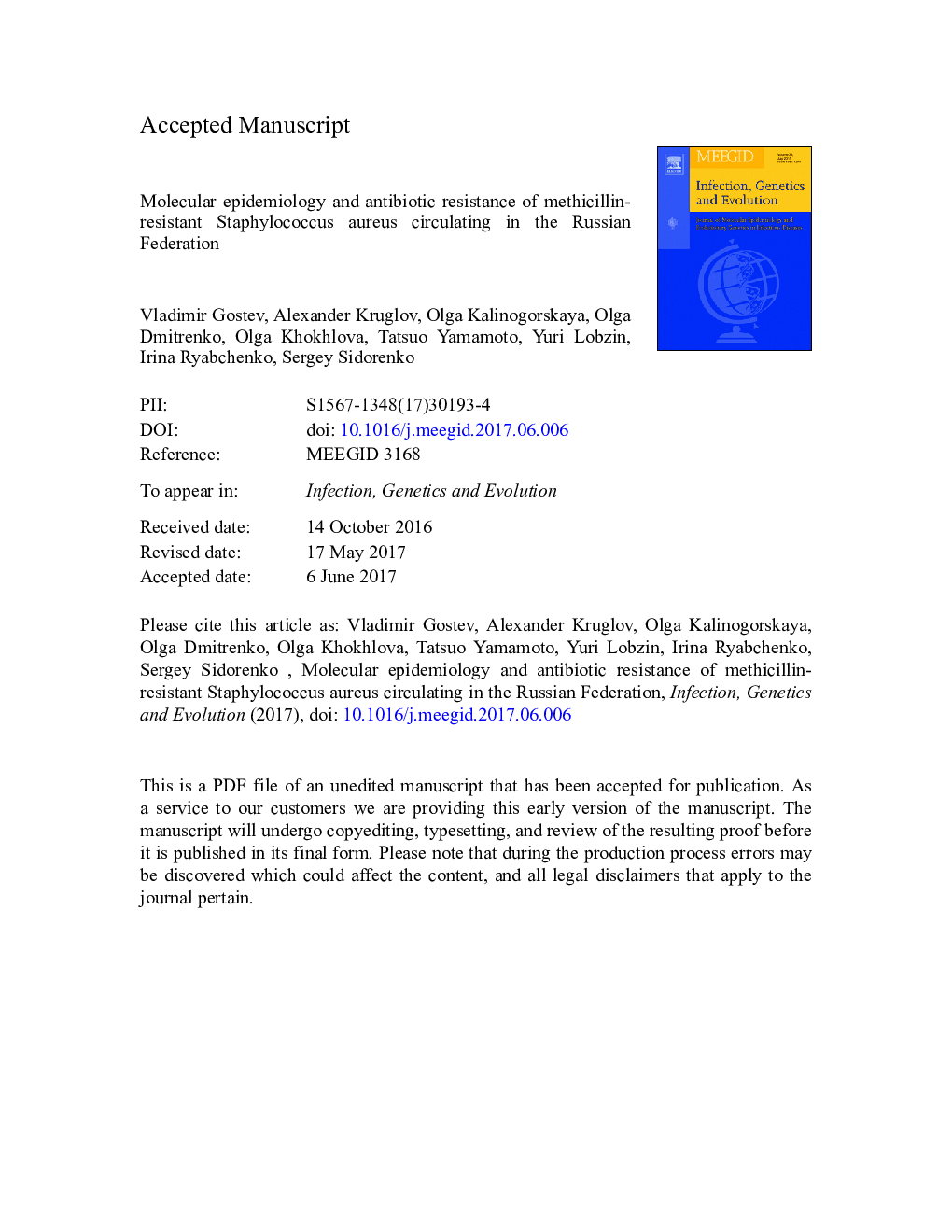| کد مقاله | کد نشریه | سال انتشار | مقاله انگلیسی | نسخه تمام متن |
|---|---|---|---|---|
| 5590671 | 1570150 | 2017 | 19 صفحه PDF | دانلود رایگان |
عنوان انگلیسی مقاله ISI
Molecular epidemiology and antibiotic resistance of methicillin-resistant Staphylococcus aureus circulating in the Russian Federation
ترجمه فارسی عنوان
اپیدمیولوژی مولکولی و مقاومت آنتی بیوتیک استافیلوکوکوس اورئوس مقاوم به متسییلین در فدراسیون روسیه
دانلود مقاله + سفارش ترجمه
دانلود مقاله ISI انگلیسی
رایگان برای ایرانیان
موضوعات مرتبط
علوم زیستی و بیوفناوری
علوم کشاورزی و بیولوژیک
بوم شناسی، تکامل، رفتار و سامانه شناسی
چکیده انگلیسی
The aim of this study was to investigate the patterns of antimicrobial resistance and molecular features of methicillin-resistant Staphylococcus aureus (MRSA) isolates in Russia. Isolates recovered from hospital patients (n = 480), healthy medical personnel (n = 25), and healthy carriers (n = 13) were included in the study. Hospital-acquired MRSA (HA-MRSA) demonstrated high resistance to ciprofloxacin, gentamicin, and chloramphenicol (76%-92%), moderate - to tetracycline, erythromycin, clindamycin, and rifampicin (38%-54%), and low - to fusidic acid, co-trimoxazole, mupirocin, and daptomycin (2%-7%). Elevated MIC (2.0 μg/ml) of vancomycin was detected in 26% of isolates. All isolates were susceptible to linezolid and tigecycline. Multilocus sequence typing (MLST) revealed that CC8 isolates (ST8 + ST239) constituted 83.1% of HA-MRSA and that this genetic lineage dominated in all regions from Krasnoyarsk to Saint Petersburg. A local ST239 variant harboring the tst gene (ST239Kras) was detected in Krasnoyarsk. The other HA-MRSA isolates belonged to clonal complex 5 (CC5) (21 isolates, 12.2%) and CC22 (2, 1.2%). The majority of CC5 isolates were affiliated with sequence type 228 (ST228) and were characterized with decreased susceptibility to ceftaroline (MIC = 2 μg/ml). We also detected, for the first time in Russia, livestock-associated MRSA (LA-MRSA) from clusters CC398 and CC97 in humans. Among the 2053 healthy persons screened for nasal carriage of S. aureus, the bacteria were isolated from 426 (21%); among them, 13 carried isolates identified as community-associated MRSA (CA-MRSA). Eleven of 13 CA-MRSA isolates belonged to ST22 (spa types t223, t3243, and t3689; SCCmec types IVa and IVc, agr type I, tst-positive) and were similar to the EMRSA-15/Middle Eastern variant (Gaza strain).
ناشر
Database: Elsevier - ScienceDirect (ساینس دایرکت)
Journal: Infection, Genetics and Evolution - Volume 53, September 2017, Pages 189-194
Journal: Infection, Genetics and Evolution - Volume 53, September 2017, Pages 189-194
نویسندگان
Vladimir Gostev, Alexander Kruglov, Olga Kalinogorskaya, Olga Dmitrenko, Olga Khokhlova, Tatsuo Yamamoto, Yuri Lobzin, Irina Ryabchenko, Sergey Sidorenko,
